Inclusion in Special Education: A Comparison of England and Portugal
VerifiedAdded on 2023/05/30
|16
|4614
|467
Essay
AI Summary
This essay provides an in-depth analysis of special education and inclusion, comparing the approaches taken in England and Portugal. It begins by highlighting the international context, referencing the United Nations Convention on the Rights of the Child and the Salamanca Statement, which advocate for inclusive education. The essay then delves into the historical development of policies supporting inclusion in both countries, examining key legislation such as the Forster Education Act in the UK and Law 66/79 in Portugal. Two journal articles, one from each country, are critically analyzed to explore inclusive practices: Santos, Sardinha, and Reis (2016) study on relationships in Portuguese inclusive classrooms, and Norwich's (2014) discussion of the capability approach in addressing special educational needs. The essay concludes by discussing the issues, challenges, and dilemmas of inclusive education, particularly focusing on the potential for labeling and the complexities of balancing individual needs with broader social participation.
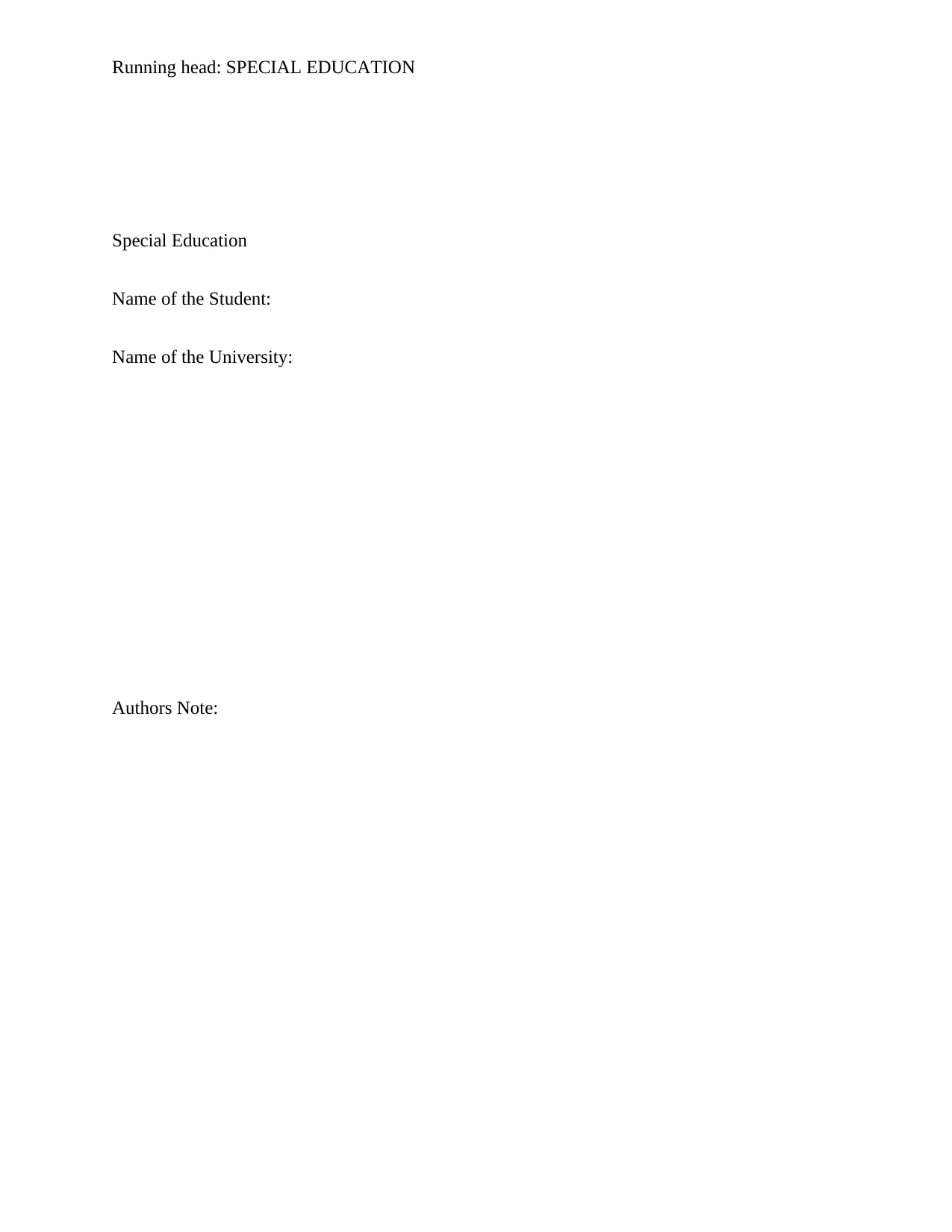
Running head: SPECIAL EDUCATION
Special Education
Name of the Student:
Name of the University:
Authors Note:
Special Education
Name of the Student:
Name of the University:
Authors Note:
Paraphrase This Document
Need a fresh take? Get an instant paraphrase of this document with our AI Paraphraser
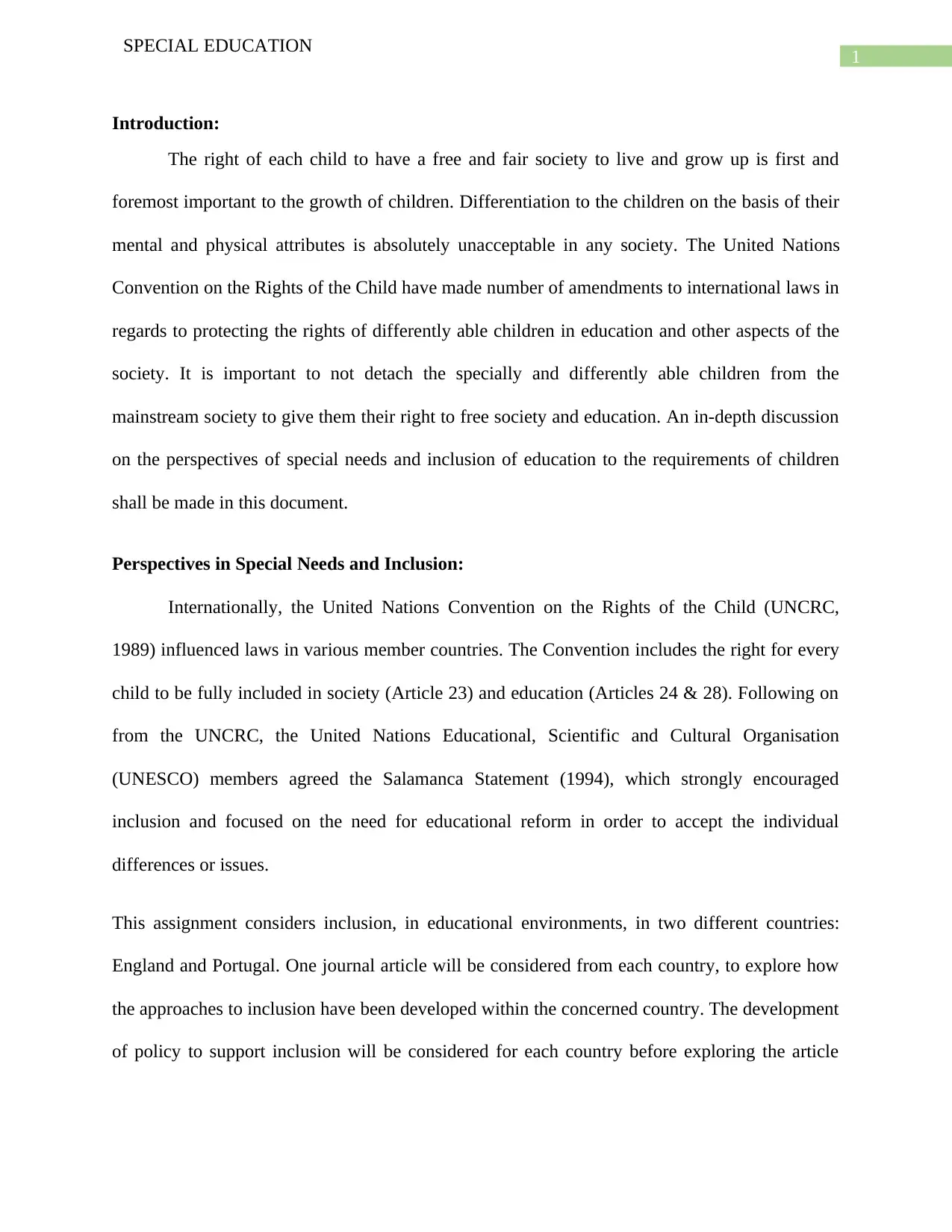
1
SPECIAL EDUCATION
Introduction:
The right of each child to have a free and fair society to live and grow up is first and
foremost important to the growth of children. Differentiation to the children on the basis of their
mental and physical attributes is absolutely unacceptable in any society. The United Nations
Convention on the Rights of the Child have made number of amendments to international laws in
regards to protecting the rights of differently able children in education and other aspects of the
society. It is important to not detach the specially and differently able children from the
mainstream society to give them their right to free society and education. An in-depth discussion
on the perspectives of special needs and inclusion of education to the requirements of children
shall be made in this document.
Perspectives in Special Needs and Inclusion:
Internationally, the United Nations Convention on the Rights of the Child (UNCRC,
1989) influenced laws in various member countries. The Convention includes the right for every
child to be fully included in society (Article 23) and education (Articles 24 & 28). Following on
from the UNCRC, the United Nations Educational, Scientific and Cultural Organisation
(UNESCO) members agreed the Salamanca Statement (1994), which strongly encouraged
inclusion and focused on the need for educational reform in order to accept the individual
differences or issues.
This assignment considers inclusion, in educational environments, in two different countries:
England and Portugal. One journal article will be considered from each country, to explore how
the approaches to inclusion have been developed within the concerned country. The development
of policy to support inclusion will be considered for each country before exploring the article
SPECIAL EDUCATION
Introduction:
The right of each child to have a free and fair society to live and grow up is first and
foremost important to the growth of children. Differentiation to the children on the basis of their
mental and physical attributes is absolutely unacceptable in any society. The United Nations
Convention on the Rights of the Child have made number of amendments to international laws in
regards to protecting the rights of differently able children in education and other aspects of the
society. It is important to not detach the specially and differently able children from the
mainstream society to give them their right to free society and education. An in-depth discussion
on the perspectives of special needs and inclusion of education to the requirements of children
shall be made in this document.
Perspectives in Special Needs and Inclusion:
Internationally, the United Nations Convention on the Rights of the Child (UNCRC,
1989) influenced laws in various member countries. The Convention includes the right for every
child to be fully included in society (Article 23) and education (Articles 24 & 28). Following on
from the UNCRC, the United Nations Educational, Scientific and Cultural Organisation
(UNESCO) members agreed the Salamanca Statement (1994), which strongly encouraged
inclusion and focused on the need for educational reform in order to accept the individual
differences or issues.
This assignment considers inclusion, in educational environments, in two different countries:
England and Portugal. One journal article will be considered from each country, to explore how
the approaches to inclusion have been developed within the concerned country. The development
of policy to support inclusion will be considered for each country before exploring the article
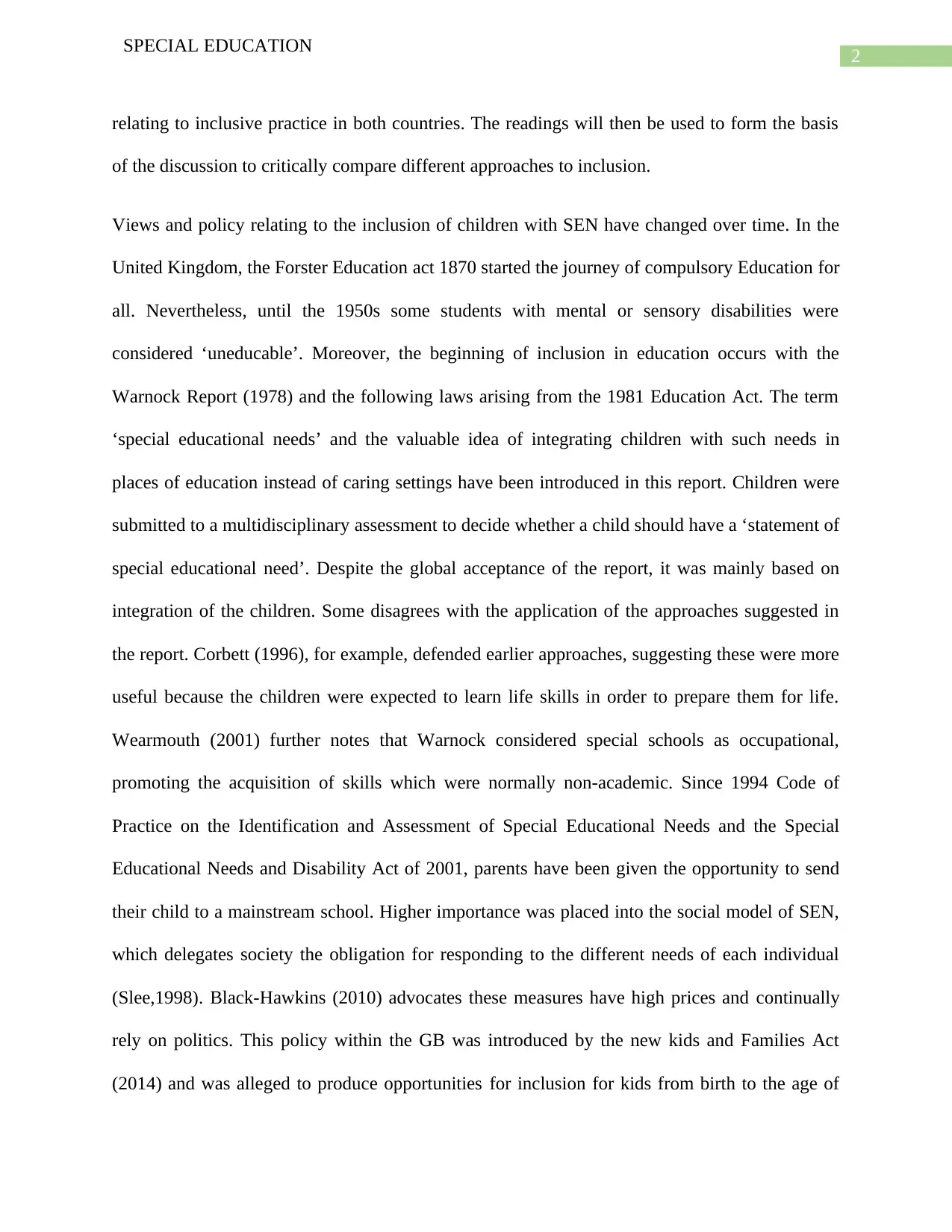
2
SPECIAL EDUCATION
relating to inclusive practice in both countries. The readings will then be used to form the basis
of the discussion to critically compare different approaches to inclusion.
Views and policy relating to the inclusion of children with SEN have changed over time. In the
United Kingdom, the Forster Education act 1870 started the journey of compulsory Education for
all. Nevertheless, until the 1950s some students with mental or sensory disabilities were
considered ‘uneducable’. Moreover, the beginning of inclusion in education occurs with the
Warnock Report (1978) and the following laws arising from the 1981 Education Act. The term
‘special educational needs’ and the valuable idea of integrating children with such needs in
places of education instead of caring settings have been introduced in this report. Children were
submitted to a multidisciplinary assessment to decide whether a child should have a ‘statement of
special educational need’. Despite the global acceptance of the report, it was mainly based on
integration of the children. Some disagrees with the application of the approaches suggested in
the report. Corbett (1996), for example, defended earlier approaches, suggesting these were more
useful because the children were expected to learn life skills in order to prepare them for life.
Wearmouth (2001) further notes that Warnock considered special schools as occupational,
promoting the acquisition of skills which were normally non-academic. Since 1994 Code of
Practice on the Identification and Assessment of Special Educational Needs and the Special
Educational Needs and Disability Act of 2001, parents have been given the opportunity to send
their child to a mainstream school. Higher importance was placed into the social model of SEN,
which delegates society the obligation for responding to the different needs of each individual
(Slee,1998). Black-Hawkins (2010) advocates these measures have high prices and continually
rely on politics. This policy within the GB was introduced by the new kids and Families Act
(2014) and was alleged to produce opportunities for inclusion for kids from birth to the age of
SPECIAL EDUCATION
relating to inclusive practice in both countries. The readings will then be used to form the basis
of the discussion to critically compare different approaches to inclusion.
Views and policy relating to the inclusion of children with SEN have changed over time. In the
United Kingdom, the Forster Education act 1870 started the journey of compulsory Education for
all. Nevertheless, until the 1950s some students with mental or sensory disabilities were
considered ‘uneducable’. Moreover, the beginning of inclusion in education occurs with the
Warnock Report (1978) and the following laws arising from the 1981 Education Act. The term
‘special educational needs’ and the valuable idea of integrating children with such needs in
places of education instead of caring settings have been introduced in this report. Children were
submitted to a multidisciplinary assessment to decide whether a child should have a ‘statement of
special educational need’. Despite the global acceptance of the report, it was mainly based on
integration of the children. Some disagrees with the application of the approaches suggested in
the report. Corbett (1996), for example, defended earlier approaches, suggesting these were more
useful because the children were expected to learn life skills in order to prepare them for life.
Wearmouth (2001) further notes that Warnock considered special schools as occupational,
promoting the acquisition of skills which were normally non-academic. Since 1994 Code of
Practice on the Identification and Assessment of Special Educational Needs and the Special
Educational Needs and Disability Act of 2001, parents have been given the opportunity to send
their child to a mainstream school. Higher importance was placed into the social model of SEN,
which delegates society the obligation for responding to the different needs of each individual
(Slee,1998). Black-Hawkins (2010) advocates these measures have high prices and continually
rely on politics. This policy within the GB was introduced by the new kids and Families Act
(2014) and was alleged to produce opportunities for inclusion for kids from birth to the age of
⊘ This is a preview!⊘
Do you want full access?
Subscribe today to unlock all pages.

Trusted by 1+ million students worldwide
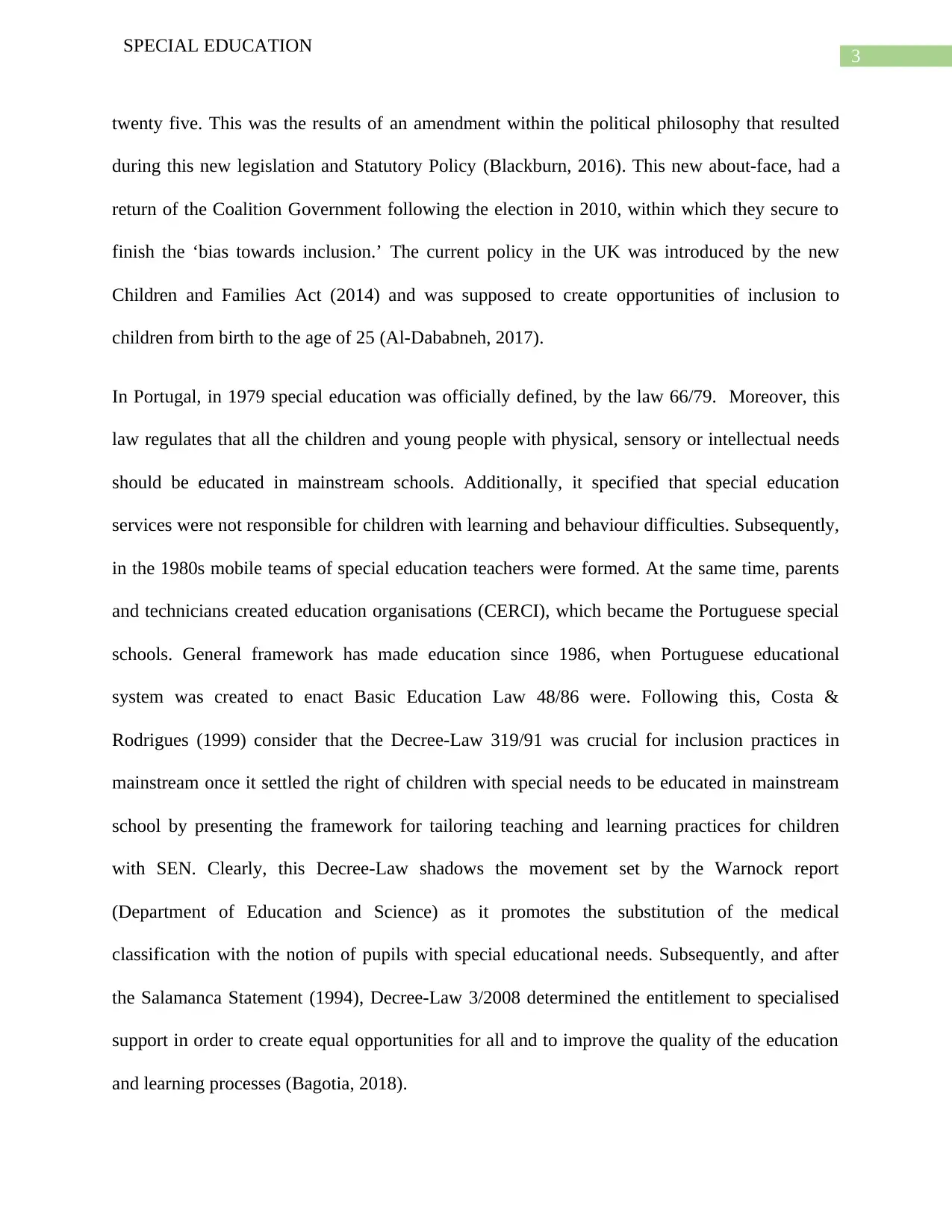
3
SPECIAL EDUCATION
twenty five. This was the results of an amendment within the political philosophy that resulted
during this new legislation and Statutory Policy (Blackburn, 2016). This new about-face, had a
return of the Coalition Government following the election in 2010, within which they secure to
finish the ‘bias towards inclusion.’ The current policy in the UK was introduced by the new
Children and Families Act (2014) and was supposed to create opportunities of inclusion to
children from birth to the age of 25 (Al-Dababneh, 2017).
In Portugal, in 1979 special education was officially defined, by the law 66/79. Moreover, this
law regulates that all the children and young people with physical, sensory or intellectual needs
should be educated in mainstream schools. Additionally, it specified that special education
services were not responsible for children with learning and behaviour difficulties. Subsequently,
in the 1980s mobile teams of special education teachers were formed. At the same time, parents
and technicians created education organisations (CERCI), which became the Portuguese special
schools. General framework has made education since 1986, when Portuguese educational
system was created to enact Basic Education Law 48/86 were. Following this, Costa &
Rodrigues (1999) consider that the Decree-Law 319/91 was crucial for inclusion practices in
mainstream once it settled the right of children with special needs to be educated in mainstream
school by presenting the framework for tailoring teaching and learning practices for children
with SEN. Clearly, this Decree-Law shadows the movement set by the Warnock report
(Department of Education and Science) as it promotes the substitution of the medical
classification with the notion of pupils with special educational needs. Subsequently, and after
the Salamanca Statement (1994), Decree-Law 3/2008 determined the entitlement to specialised
support in order to create equal opportunities for all and to improve the quality of the education
and learning processes (Bagotia, 2018).
SPECIAL EDUCATION
twenty five. This was the results of an amendment within the political philosophy that resulted
during this new legislation and Statutory Policy (Blackburn, 2016). This new about-face, had a
return of the Coalition Government following the election in 2010, within which they secure to
finish the ‘bias towards inclusion.’ The current policy in the UK was introduced by the new
Children and Families Act (2014) and was supposed to create opportunities of inclusion to
children from birth to the age of 25 (Al-Dababneh, 2017).
In Portugal, in 1979 special education was officially defined, by the law 66/79. Moreover, this
law regulates that all the children and young people with physical, sensory or intellectual needs
should be educated in mainstream schools. Additionally, it specified that special education
services were not responsible for children with learning and behaviour difficulties. Subsequently,
in the 1980s mobile teams of special education teachers were formed. At the same time, parents
and technicians created education organisations (CERCI), which became the Portuguese special
schools. General framework has made education since 1986, when Portuguese educational
system was created to enact Basic Education Law 48/86 were. Following this, Costa &
Rodrigues (1999) consider that the Decree-Law 319/91 was crucial for inclusion practices in
mainstream once it settled the right of children with special needs to be educated in mainstream
school by presenting the framework for tailoring teaching and learning practices for children
with SEN. Clearly, this Decree-Law shadows the movement set by the Warnock report
(Department of Education and Science) as it promotes the substitution of the medical
classification with the notion of pupils with special educational needs. Subsequently, and after
the Salamanca Statement (1994), Decree-Law 3/2008 determined the entitlement to specialised
support in order to create equal opportunities for all and to improve the quality of the education
and learning processes (Bagotia, 2018).
Paraphrase This Document
Need a fresh take? Get an instant paraphrase of this document with our AI Paraphraser
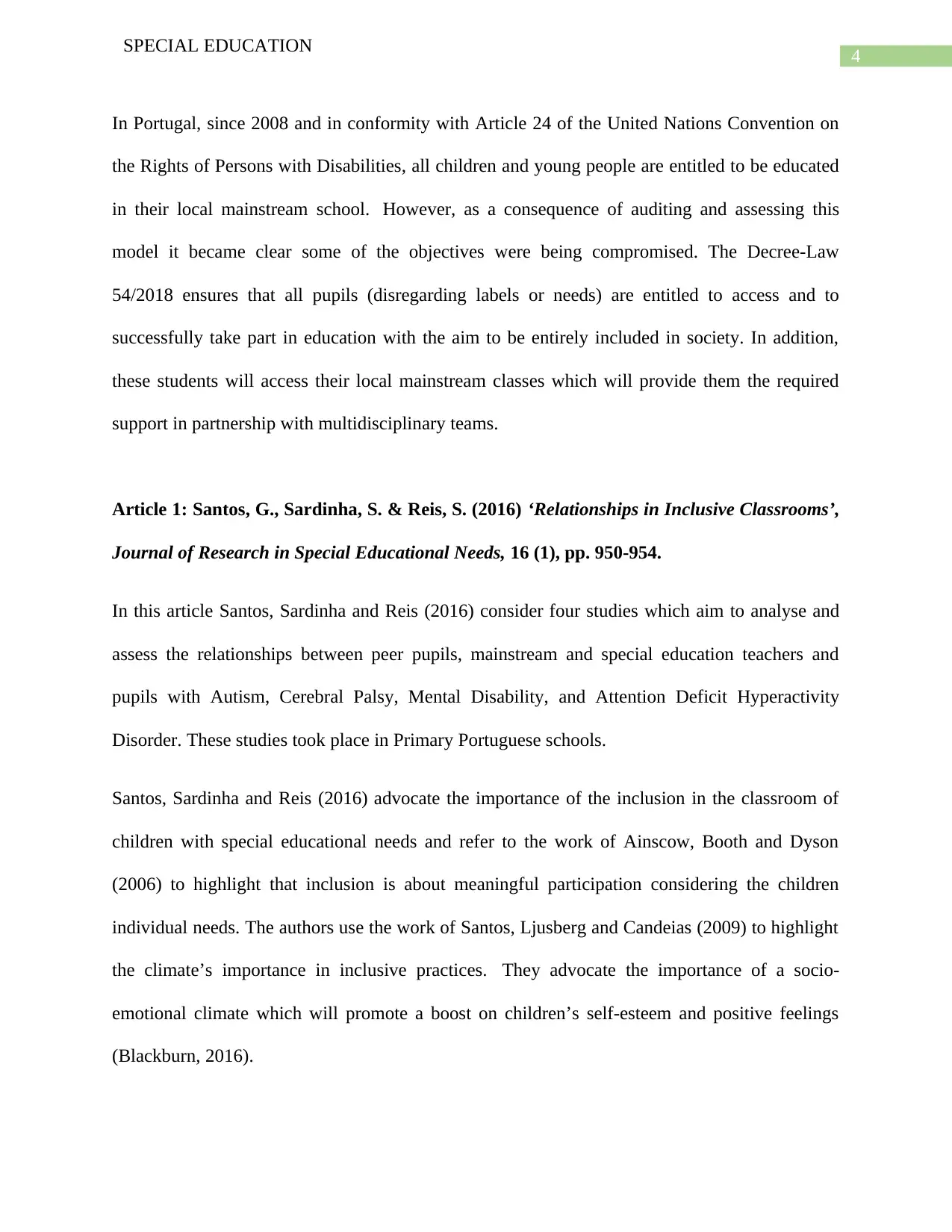
4
SPECIAL EDUCATION
In Portugal, since 2008 and in conformity with Article 24 of the United Nations Convention on
the Rights of Persons with Disabilities, all children and young people are entitled to be educated
in their local mainstream school. However, as a consequence of auditing and assessing this
model it became clear some of the objectives were being compromised. The Decree-Law
54/2018 ensures that all pupils (disregarding labels or needs) are entitled to access and to
successfully take part in education with the aim to be entirely included in society. In addition,
these students will access their local mainstream classes which will provide them the required
support in partnership with multidisciplinary teams.
Article 1: Santos, G., Sardinha, S. & Reis, S. (2016) ‘Relationships in Inclusive Classrooms’,
Journal of Research in Special Educational Needs, 16 (1), pp. 950-954.
In this article Santos, Sardinha and Reis (2016) consider four studies which aim to analyse and
assess the relationships between peer pupils, mainstream and special education teachers and
pupils with Autism, Cerebral Palsy, Mental Disability, and Attention Deficit Hyperactivity
Disorder. These studies took place in Primary Portuguese schools.
Santos, Sardinha and Reis (2016) advocate the importance of the inclusion in the classroom of
children with special educational needs and refer to the work of Ainscow, Booth and Dyson
(2006) to highlight that inclusion is about meaningful participation considering the children
individual needs. The authors use the work of Santos, Ljusberg and Candeias (2009) to highlight
the climate’s importance in inclusive practices. They advocate the importance of a socio-
emotional climate which will promote a boost on children’s self-esteem and positive feelings
(Blackburn, 2016).
SPECIAL EDUCATION
In Portugal, since 2008 and in conformity with Article 24 of the United Nations Convention on
the Rights of Persons with Disabilities, all children and young people are entitled to be educated
in their local mainstream school. However, as a consequence of auditing and assessing this
model it became clear some of the objectives were being compromised. The Decree-Law
54/2018 ensures that all pupils (disregarding labels or needs) are entitled to access and to
successfully take part in education with the aim to be entirely included in society. In addition,
these students will access their local mainstream classes which will provide them the required
support in partnership with multidisciplinary teams.
Article 1: Santos, G., Sardinha, S. & Reis, S. (2016) ‘Relationships in Inclusive Classrooms’,
Journal of Research in Special Educational Needs, 16 (1), pp. 950-954.
In this article Santos, Sardinha and Reis (2016) consider four studies which aim to analyse and
assess the relationships between peer pupils, mainstream and special education teachers and
pupils with Autism, Cerebral Palsy, Mental Disability, and Attention Deficit Hyperactivity
Disorder. These studies took place in Primary Portuguese schools.
Santos, Sardinha and Reis (2016) advocate the importance of the inclusion in the classroom of
children with special educational needs and refer to the work of Ainscow, Booth and Dyson
(2006) to highlight that inclusion is about meaningful participation considering the children
individual needs. The authors use the work of Santos, Ljusberg and Candeias (2009) to highlight
the climate’s importance in inclusive practices. They advocate the importance of a socio-
emotional climate which will promote a boost on children’s self-esteem and positive feelings
(Blackburn, 2016).
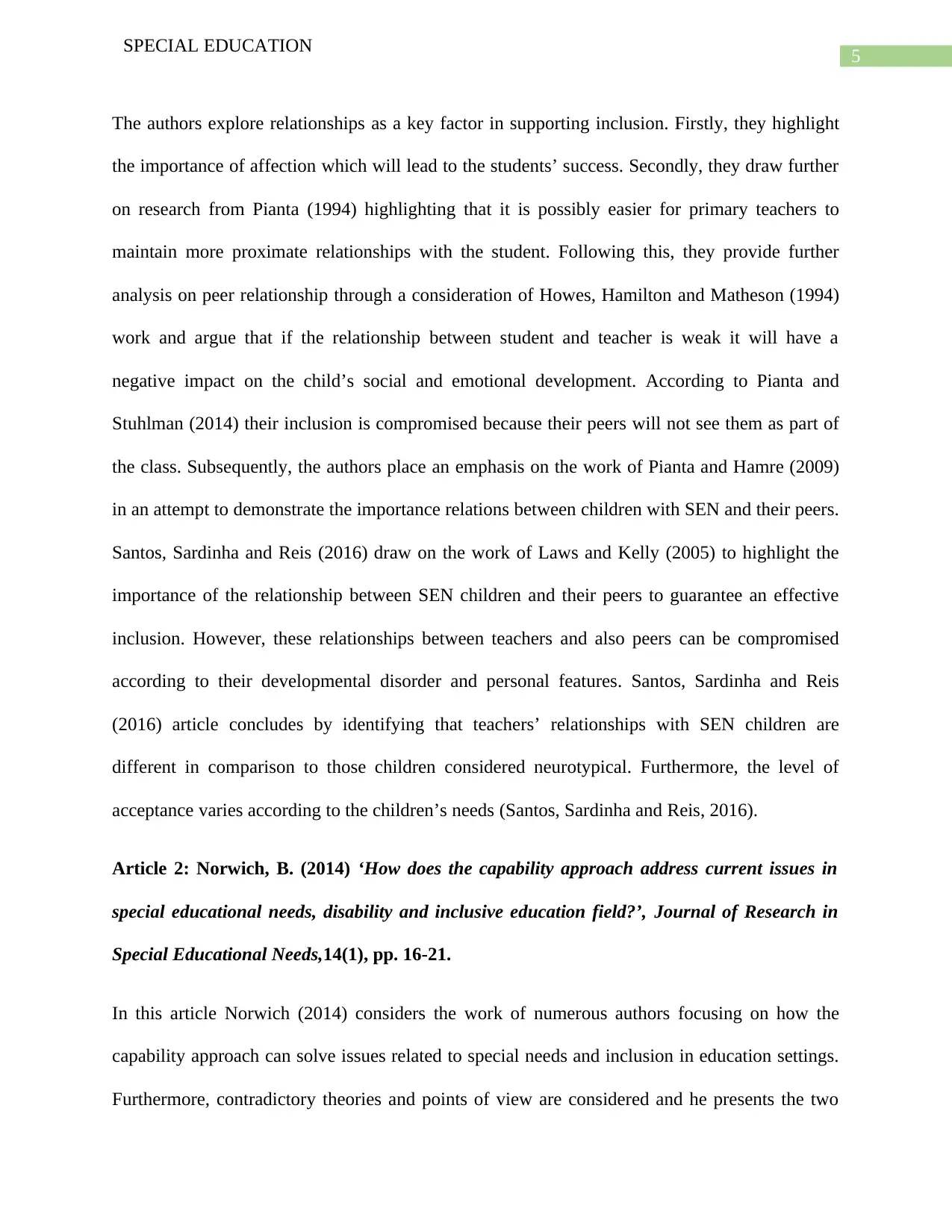
5
SPECIAL EDUCATION
The authors explore relationships as a key factor in supporting inclusion. Firstly, they highlight
the importance of affection which will lead to the students’ success. Secondly, they draw further
on research from Pianta (1994) highlighting that it is possibly easier for primary teachers to
maintain more proximate relationships with the student. Following this, they provide further
analysis on peer relationship through a consideration of Howes, Hamilton and Matheson (1994)
work and argue that if the relationship between student and teacher is weak it will have a
negative impact on the child’s social and emotional development. According to Pianta and
Stuhlman (2014) their inclusion is compromised because their peers will not see them as part of
the class. Subsequently, the authors place an emphasis on the work of Pianta and Hamre (2009)
in an attempt to demonstrate the importance relations between children with SEN and their peers.
Santos, Sardinha and Reis (2016) draw on the work of Laws and Kelly (2005) to highlight the
importance of the relationship between SEN children and their peers to guarantee an effective
inclusion. However, these relationships between teachers and also peers can be compromised
according to their developmental disorder and personal features. Santos, Sardinha and Reis
(2016) article concludes by identifying that teachers’ relationships with SEN children are
different in comparison to those children considered neurotypical. Furthermore, the level of
acceptance varies according to the children’s needs (Santos, Sardinha and Reis, 2016).
Article 2: Norwich, B. (2014) ‘How does the capability approach address current issues in
special educational needs, disability and inclusive education field?’, Journal of Research in
Special Educational Needs,14(1), pp. 16-21.
In this article Norwich (2014) considers the work of numerous authors focusing on how the
capability approach can solve issues related to special needs and inclusion in education settings.
Furthermore, contradictory theories and points of view are considered and he presents the two
SPECIAL EDUCATION
The authors explore relationships as a key factor in supporting inclusion. Firstly, they highlight
the importance of affection which will lead to the students’ success. Secondly, they draw further
on research from Pianta (1994) highlighting that it is possibly easier for primary teachers to
maintain more proximate relationships with the student. Following this, they provide further
analysis on peer relationship through a consideration of Howes, Hamilton and Matheson (1994)
work and argue that if the relationship between student and teacher is weak it will have a
negative impact on the child’s social and emotional development. According to Pianta and
Stuhlman (2014) their inclusion is compromised because their peers will not see them as part of
the class. Subsequently, the authors place an emphasis on the work of Pianta and Hamre (2009)
in an attempt to demonstrate the importance relations between children with SEN and their peers.
Santos, Sardinha and Reis (2016) draw on the work of Laws and Kelly (2005) to highlight the
importance of the relationship between SEN children and their peers to guarantee an effective
inclusion. However, these relationships between teachers and also peers can be compromised
according to their developmental disorder and personal features. Santos, Sardinha and Reis
(2016) article concludes by identifying that teachers’ relationships with SEN children are
different in comparison to those children considered neurotypical. Furthermore, the level of
acceptance varies according to the children’s needs (Santos, Sardinha and Reis, 2016).
Article 2: Norwich, B. (2014) ‘How does the capability approach address current issues in
special educational needs, disability and inclusive education field?’, Journal of Research in
Special Educational Needs,14(1), pp. 16-21.
In this article Norwich (2014) considers the work of numerous authors focusing on how the
capability approach can solve issues related to special needs and inclusion in education settings.
Furthermore, contradictory theories and points of view are considered and he presents the two
⊘ This is a preview!⊘
Do you want full access?
Subscribe today to unlock all pages.

Trusted by 1+ million students worldwide
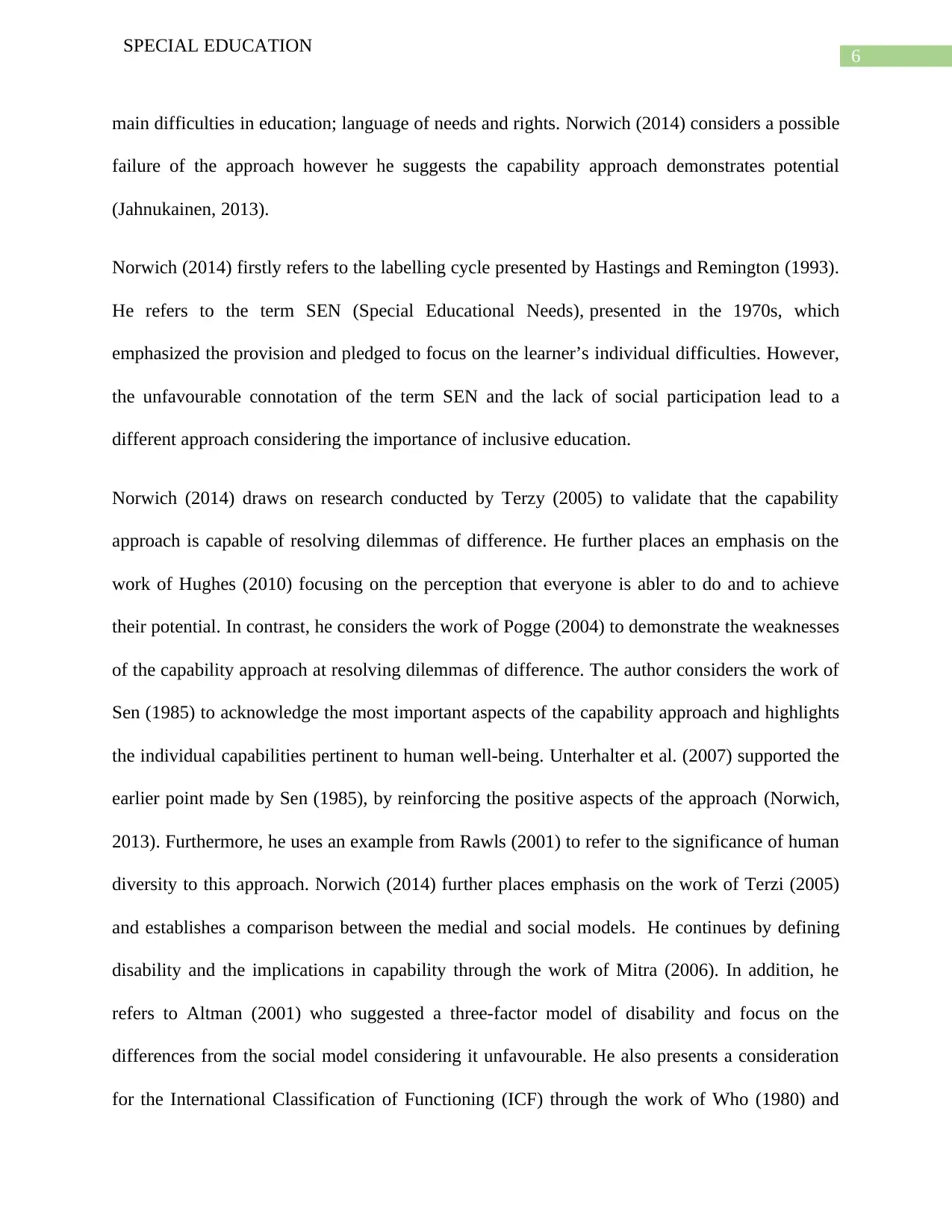
6
SPECIAL EDUCATION
main difficulties in education; language of needs and rights. Norwich (2014) considers a possible
failure of the approach however he suggests the capability approach demonstrates potential
(Jahnukainen, 2013).
Norwich (2014) firstly refers to the labelling cycle presented by Hastings and Remington (1993).
He refers to the term SEN (Special Educational Needs), presented in the 1970s, which
emphasized the provision and pledged to focus on the learner’s individual difficulties. However,
the unfavourable connotation of the term SEN and the lack of social participation lead to a
different approach considering the importance of inclusive education.
Norwich (2014) draws on research conducted by Terzy (2005) to validate that the capability
approach is capable of resolving dilemmas of difference. He further places an emphasis on the
work of Hughes (2010) focusing on the perception that everyone is abler to do and to achieve
their potential. In contrast, he considers the work of Pogge (2004) to demonstrate the weaknesses
of the capability approach at resolving dilemmas of difference. The author considers the work of
Sen (1985) to acknowledge the most important aspects of the capability approach and highlights
the individual capabilities pertinent to human well-being. Unterhalter et al. (2007) supported the
earlier point made by Sen (1985), by reinforcing the positive aspects of the approach (Norwich,
2013). Furthermore, he uses an example from Rawls (2001) to refer to the significance of human
diversity to this approach. Norwich (2014) further places emphasis on the work of Terzi (2005)
and establishes a comparison between the medial and social models. He continues by defining
disability and the implications in capability through the work of Mitra (2006). In addition, he
refers to Altman (2001) who suggested a three-factor model of disability and focus on the
differences from the social model considering it unfavourable. He also presents a consideration
for the International Classification of Functioning (ICF) through the work of Who (1980) and
SPECIAL EDUCATION
main difficulties in education; language of needs and rights. Norwich (2014) considers a possible
failure of the approach however he suggests the capability approach demonstrates potential
(Jahnukainen, 2013).
Norwich (2014) firstly refers to the labelling cycle presented by Hastings and Remington (1993).
He refers to the term SEN (Special Educational Needs), presented in the 1970s, which
emphasized the provision and pledged to focus on the learner’s individual difficulties. However,
the unfavourable connotation of the term SEN and the lack of social participation lead to a
different approach considering the importance of inclusive education.
Norwich (2014) draws on research conducted by Terzy (2005) to validate that the capability
approach is capable of resolving dilemmas of difference. He further places an emphasis on the
work of Hughes (2010) focusing on the perception that everyone is abler to do and to achieve
their potential. In contrast, he considers the work of Pogge (2004) to demonstrate the weaknesses
of the capability approach at resolving dilemmas of difference. The author considers the work of
Sen (1985) to acknowledge the most important aspects of the capability approach and highlights
the individual capabilities pertinent to human well-being. Unterhalter et al. (2007) supported the
earlier point made by Sen (1985), by reinforcing the positive aspects of the approach (Norwich,
2013). Furthermore, he uses an example from Rawls (2001) to refer to the significance of human
diversity to this approach. Norwich (2014) further places emphasis on the work of Terzi (2005)
and establishes a comparison between the medial and social models. He continues by defining
disability and the implications in capability through the work of Mitra (2006). In addition, he
refers to Altman (2001) who suggested a three-factor model of disability and focus on the
differences from the social model considering it unfavourable. He also presents a consideration
for the International Classification of Functioning (ICF) through the work of Who (1980) and
Paraphrase This Document
Need a fresh take? Get an instant paraphrase of this document with our AI Paraphraser
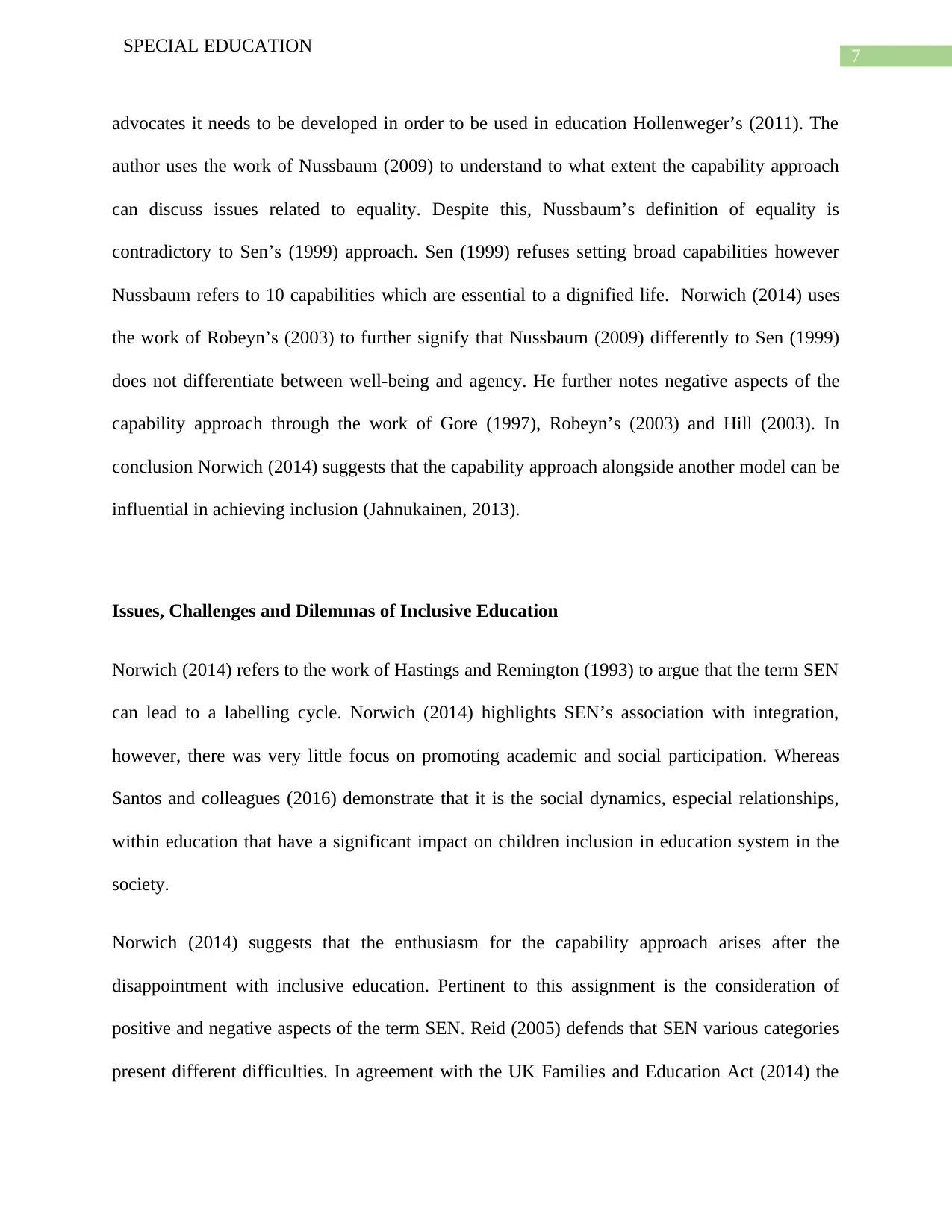
7
SPECIAL EDUCATION
advocates it needs to be developed in order to be used in education Hollenweger’s (2011). The
author uses the work of Nussbaum (2009) to understand to what extent the capability approach
can discuss issues related to equality. Despite this, Nussbaum’s definition of equality is
contradictory to Sen’s (1999) approach. Sen (1999) refuses setting broad capabilities however
Nussbaum refers to 10 capabilities which are essential to a dignified life. Norwich (2014) uses
the work of Robeyn’s (2003) to further signify that Nussbaum (2009) differently to Sen (1999)
does not differentiate between well-being and agency. He further notes negative aspects of the
capability approach through the work of Gore (1997), Robeyn’s (2003) and Hill (2003). In
conclusion Norwich (2014) suggests that the capability approach alongside another model can be
influential in achieving inclusion (Jahnukainen, 2013).
Issues, Challenges and Dilemmas of Inclusive Education
Norwich (2014) refers to the work of Hastings and Remington (1993) to argue that the term SEN
can lead to a labelling cycle. Norwich (2014) highlights SEN’s association with integration,
however, there was very little focus on promoting academic and social participation. Whereas
Santos and colleagues (2016) demonstrate that it is the social dynamics, especial relationships,
within education that have a significant impact on children inclusion in education system in the
society.
Norwich (2014) suggests that the enthusiasm for the capability approach arises after the
disappointment with inclusive education. Pertinent to this assignment is the consideration of
positive and negative aspects of the term SEN. Reid (2005) defends that SEN various categories
present different difficulties. In agreement with the UK Families and Education Act (2014) the
SPECIAL EDUCATION
advocates it needs to be developed in order to be used in education Hollenweger’s (2011). The
author uses the work of Nussbaum (2009) to understand to what extent the capability approach
can discuss issues related to equality. Despite this, Nussbaum’s definition of equality is
contradictory to Sen’s (1999) approach. Sen (1999) refuses setting broad capabilities however
Nussbaum refers to 10 capabilities which are essential to a dignified life. Norwich (2014) uses
the work of Robeyn’s (2003) to further signify that Nussbaum (2009) differently to Sen (1999)
does not differentiate between well-being and agency. He further notes negative aspects of the
capability approach through the work of Gore (1997), Robeyn’s (2003) and Hill (2003). In
conclusion Norwich (2014) suggests that the capability approach alongside another model can be
influential in achieving inclusion (Jahnukainen, 2013).
Issues, Challenges and Dilemmas of Inclusive Education
Norwich (2014) refers to the work of Hastings and Remington (1993) to argue that the term SEN
can lead to a labelling cycle. Norwich (2014) highlights SEN’s association with integration,
however, there was very little focus on promoting academic and social participation. Whereas
Santos and colleagues (2016) demonstrate that it is the social dynamics, especial relationships,
within education that have a significant impact on children inclusion in education system in the
society.
Norwich (2014) suggests that the enthusiasm for the capability approach arises after the
disappointment with inclusive education. Pertinent to this assignment is the consideration of
positive and negative aspects of the term SEN. Reid (2005) defends that SEN various categories
present different difficulties. In agreement with the UK Families and Education Act (2014) the
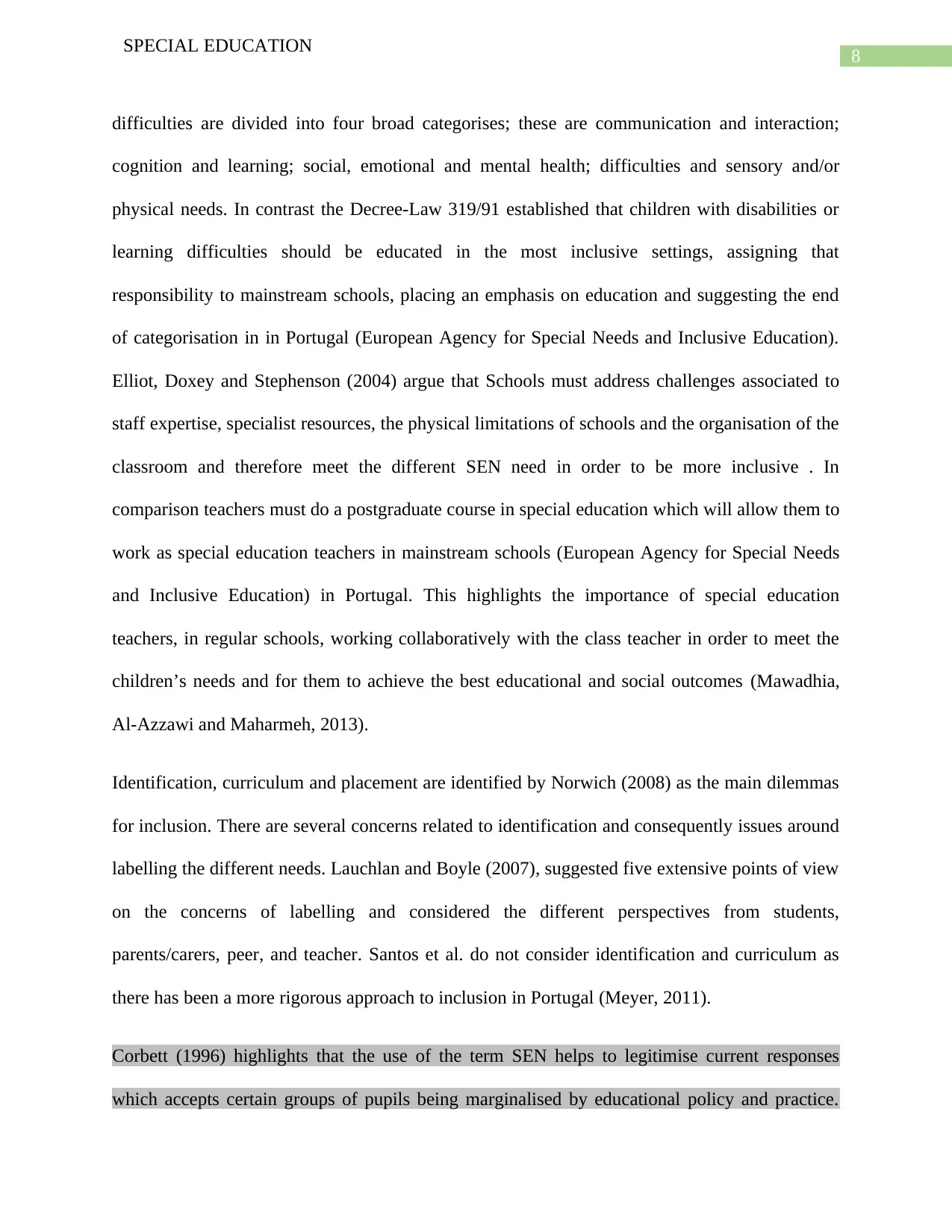
8
SPECIAL EDUCATION
difficulties are divided into four broad categorises; these are communication and interaction;
cognition and learning; social, emotional and mental health; difficulties and sensory and/or
physical needs. In contrast the Decree-Law 319/91 established that children with disabilities or
learning difficulties should be educated in the most inclusive settings, assigning that
responsibility to mainstream schools, placing an emphasis on education and suggesting the end
of categorisation in in Portugal (European Agency for Special Needs and Inclusive Education).
Elliot, Doxey and Stephenson (2004) argue that Schools must address challenges associated to
staff expertise, specialist resources, the physical limitations of schools and the organisation of the
classroom and therefore meet the different SEN need in order to be more inclusive . In
comparison teachers must do a postgraduate course in special education which will allow them to
work as special education teachers in mainstream schools (European Agency for Special Needs
and Inclusive Education) in Portugal. This highlights the importance of special education
teachers, in regular schools, working collaboratively with the class teacher in order to meet the
children’s needs and for them to achieve the best educational and social outcomes (Mawadhia,
Al-Azzawi and Maharmeh, 2013).
Identification, curriculum and placement are identified by Norwich (2008) as the main dilemmas
for inclusion. There are several concerns related to identification and consequently issues around
labelling the different needs. Lauchlan and Boyle (2007), suggested five extensive points of view
on the concerns of labelling and considered the different perspectives from students,
parents/carers, peer, and teacher. Santos et al. do not consider identification and curriculum as
there has been a more rigorous approach to inclusion in Portugal (Meyer, 2011).
Corbett (1996) highlights that the use of the term SEN helps to legitimise current responses
which accepts certain groups of pupils being marginalised by educational policy and practice.
SPECIAL EDUCATION
difficulties are divided into four broad categorises; these are communication and interaction;
cognition and learning; social, emotional and mental health; difficulties and sensory and/or
physical needs. In contrast the Decree-Law 319/91 established that children with disabilities or
learning difficulties should be educated in the most inclusive settings, assigning that
responsibility to mainstream schools, placing an emphasis on education and suggesting the end
of categorisation in in Portugal (European Agency for Special Needs and Inclusive Education).
Elliot, Doxey and Stephenson (2004) argue that Schools must address challenges associated to
staff expertise, specialist resources, the physical limitations of schools and the organisation of the
classroom and therefore meet the different SEN need in order to be more inclusive . In
comparison teachers must do a postgraduate course in special education which will allow them to
work as special education teachers in mainstream schools (European Agency for Special Needs
and Inclusive Education) in Portugal. This highlights the importance of special education
teachers, in regular schools, working collaboratively with the class teacher in order to meet the
children’s needs and for them to achieve the best educational and social outcomes (Mawadhia,
Al-Azzawi and Maharmeh, 2013).
Identification, curriculum and placement are identified by Norwich (2008) as the main dilemmas
for inclusion. There are several concerns related to identification and consequently issues around
labelling the different needs. Lauchlan and Boyle (2007), suggested five extensive points of view
on the concerns of labelling and considered the different perspectives from students,
parents/carers, peer, and teacher. Santos et al. do not consider identification and curriculum as
there has been a more rigorous approach to inclusion in Portugal (Meyer, 2011).
Corbett (1996) highlights that the use of the term SEN helps to legitimise current responses
which accepts certain groups of pupils being marginalised by educational policy and practice.
⊘ This is a preview!⊘
Do you want full access?
Subscribe today to unlock all pages.

Trusted by 1+ million students worldwide
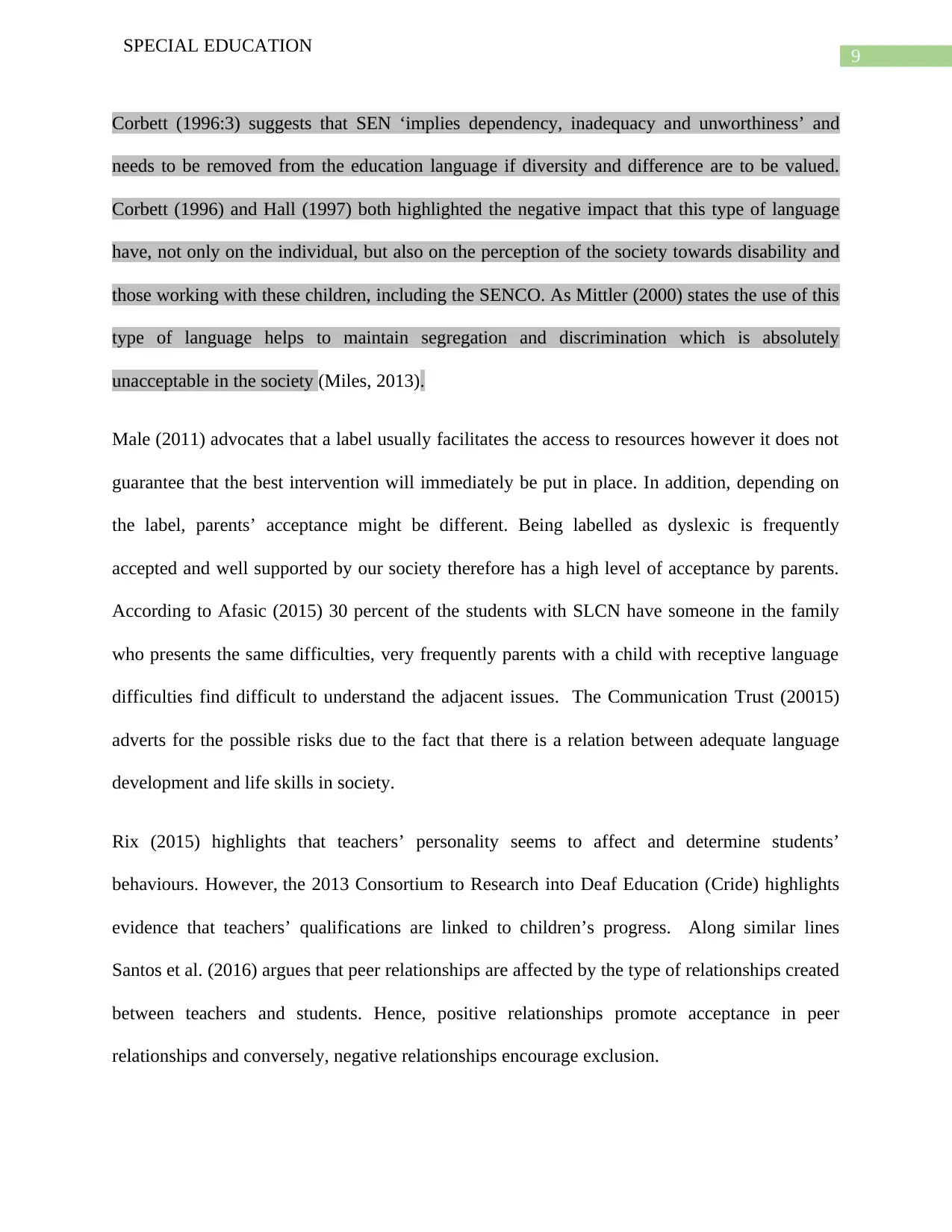
9
SPECIAL EDUCATION
Corbett (1996:3) suggests that SEN ‘implies dependency, inadequacy and unworthiness’ and
needs to be removed from the education language if diversity and difference are to be valued.
Corbett (1996) and Hall (1997) both highlighted the negative impact that this type of language
have, not only on the individual, but also on the perception of the society towards disability and
those working with these children, including the SENCO. As Mittler (2000) states the use of this
type of language helps to maintain segregation and discrimination which is absolutely
unacceptable in the society (Miles, 2013).
Male (2011) advocates that a label usually facilitates the access to resources however it does not
guarantee that the best intervention will immediately be put in place. In addition, depending on
the label, parents’ acceptance might be different. Being labelled as dyslexic is frequently
accepted and well supported by our society therefore has a high level of acceptance by parents.
According to Afasic (2015) 30 percent of the students with SLCN have someone in the family
who presents the same difficulties, very frequently parents with a child with receptive language
difficulties find difficult to understand the adjacent issues. The Communication Trust (20015)
adverts for the possible risks due to the fact that there is a relation between adequate language
development and life skills in society.
Rix (2015) highlights that teachers’ personality seems to affect and determine students’
behaviours. However, the 2013 Consortium to Research into Deaf Education (Cride) highlights
evidence that teachers’ qualifications are linked to children’s progress. Along similar lines
Santos et al. (2016) argues that peer relationships are affected by the type of relationships created
between teachers and students. Hence, positive relationships promote acceptance in peer
relationships and conversely, negative relationships encourage exclusion.
SPECIAL EDUCATION
Corbett (1996:3) suggests that SEN ‘implies dependency, inadequacy and unworthiness’ and
needs to be removed from the education language if diversity and difference are to be valued.
Corbett (1996) and Hall (1997) both highlighted the negative impact that this type of language
have, not only on the individual, but also on the perception of the society towards disability and
those working with these children, including the SENCO. As Mittler (2000) states the use of this
type of language helps to maintain segregation and discrimination which is absolutely
unacceptable in the society (Miles, 2013).
Male (2011) advocates that a label usually facilitates the access to resources however it does not
guarantee that the best intervention will immediately be put in place. In addition, depending on
the label, parents’ acceptance might be different. Being labelled as dyslexic is frequently
accepted and well supported by our society therefore has a high level of acceptance by parents.
According to Afasic (2015) 30 percent of the students with SLCN have someone in the family
who presents the same difficulties, very frequently parents with a child with receptive language
difficulties find difficult to understand the adjacent issues. The Communication Trust (20015)
adverts for the possible risks due to the fact that there is a relation between adequate language
development and life skills in society.
Rix (2015) highlights that teachers’ personality seems to affect and determine students’
behaviours. However, the 2013 Consortium to Research into Deaf Education (Cride) highlights
evidence that teachers’ qualifications are linked to children’s progress. Along similar lines
Santos et al. (2016) argues that peer relationships are affected by the type of relationships created
between teachers and students. Hence, positive relationships promote acceptance in peer
relationships and conversely, negative relationships encourage exclusion.
Paraphrase This Document
Need a fresh take? Get an instant paraphrase of this document with our AI Paraphraser
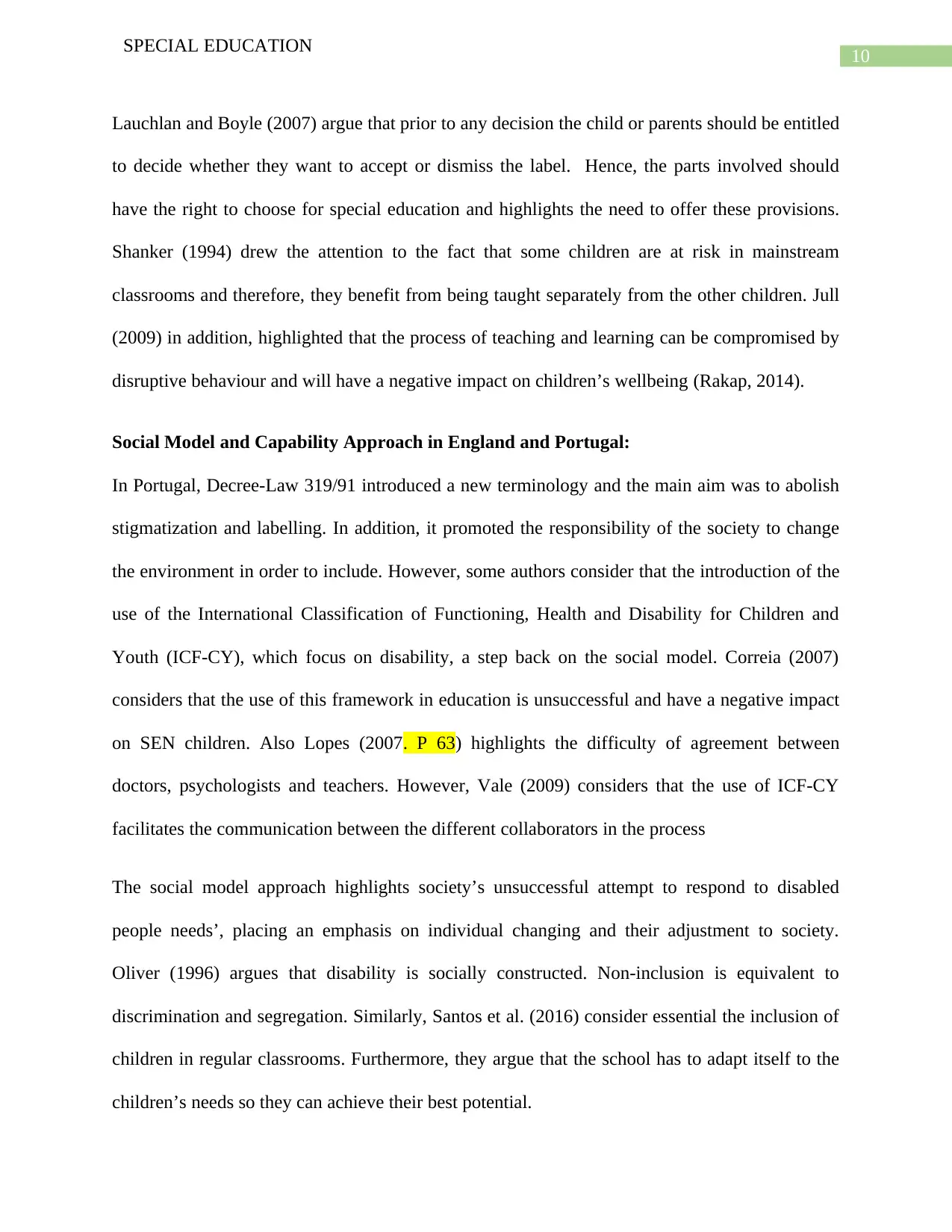
10
SPECIAL EDUCATION
Lauchlan and Boyle (2007) argue that prior to any decision the child or parents should be entitled
to decide whether they want to accept or dismiss the label. Hence, the parts involved should
have the right to choose for special education and highlights the need to offer these provisions.
Shanker (1994) drew the attention to the fact that some children are at risk in mainstream
classrooms and therefore, they benefit from being taught separately from the other children. Jull
(2009) in addition, highlighted that the process of teaching and learning can be compromised by
disruptive behaviour and will have a negative impact on children’s wellbeing (Rakap, 2014).
Social Model and Capability Approach in England and Portugal:
In Portugal, Decree-Law 319/91 introduced a new terminology and the main aim was to abolish
stigmatization and labelling. In addition, it promoted the responsibility of the society to change
the environment in order to include. However, some authors consider that the introduction of the
use of the International Classification of Functioning, Health and Disability for Children and
Youth (ICF-CY), which focus on disability, a step back on the social model. Correia (2007)
considers that the use of this framework in education is unsuccessful and have a negative impact
on SEN children. Also Lopes (2007. P 63) highlights the difficulty of agreement between
doctors, psychologists and teachers. However, Vale (2009) considers that the use of ICF-CY
facilitates the communication between the different collaborators in the process
The social model approach highlights society’s unsuccessful attempt to respond to disabled
people needs’, placing an emphasis on individual changing and their adjustment to society.
Oliver (1996) argues that disability is socially constructed. Non-inclusion is equivalent to
discrimination and segregation. Similarly, Santos et al. (2016) consider essential the inclusion of
children in regular classrooms. Furthermore, they argue that the school has to adapt itself to the
children’s needs so they can achieve their best potential.
SPECIAL EDUCATION
Lauchlan and Boyle (2007) argue that prior to any decision the child or parents should be entitled
to decide whether they want to accept or dismiss the label. Hence, the parts involved should
have the right to choose for special education and highlights the need to offer these provisions.
Shanker (1994) drew the attention to the fact that some children are at risk in mainstream
classrooms and therefore, they benefit from being taught separately from the other children. Jull
(2009) in addition, highlighted that the process of teaching and learning can be compromised by
disruptive behaviour and will have a negative impact on children’s wellbeing (Rakap, 2014).
Social Model and Capability Approach in England and Portugal:
In Portugal, Decree-Law 319/91 introduced a new terminology and the main aim was to abolish
stigmatization and labelling. In addition, it promoted the responsibility of the society to change
the environment in order to include. However, some authors consider that the introduction of the
use of the International Classification of Functioning, Health and Disability for Children and
Youth (ICF-CY), which focus on disability, a step back on the social model. Correia (2007)
considers that the use of this framework in education is unsuccessful and have a negative impact
on SEN children. Also Lopes (2007. P 63) highlights the difficulty of agreement between
doctors, psychologists and teachers. However, Vale (2009) considers that the use of ICF-CY
facilitates the communication between the different collaborators in the process
The social model approach highlights society’s unsuccessful attempt to respond to disabled
people needs’, placing an emphasis on individual changing and their adjustment to society.
Oliver (1996) argues that disability is socially constructed. Non-inclusion is equivalent to
discrimination and segregation. Similarly, Santos et al. (2016) consider essential the inclusion of
children in regular classrooms. Furthermore, they argue that the school has to adapt itself to the
children’s needs so they can achieve their best potential.
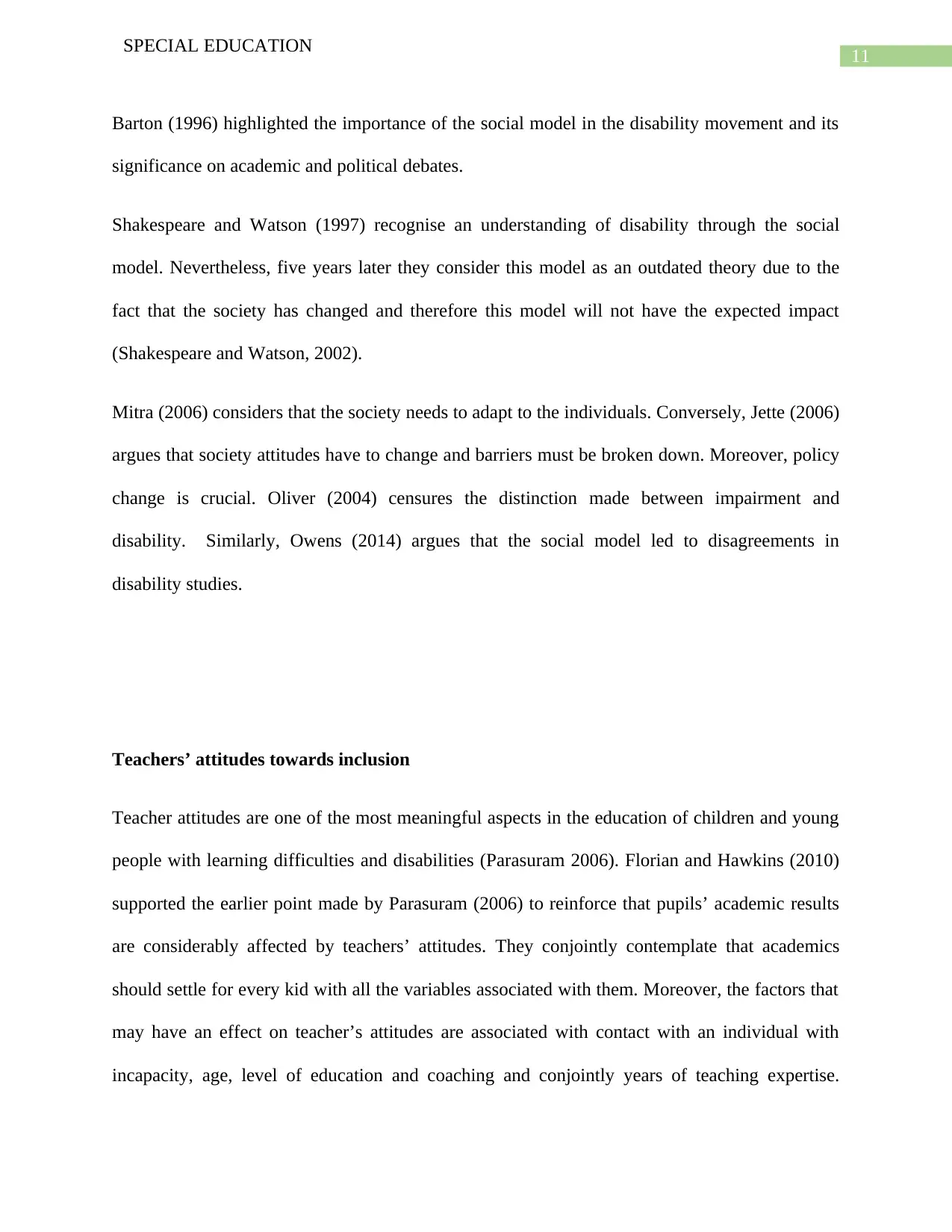
11
SPECIAL EDUCATION
Barton (1996) highlighted the importance of the social model in the disability movement and its
significance on academic and political debates.
Shakespeare and Watson (1997) recognise an understanding of disability through the social
model. Nevertheless, five years later they consider this model as an outdated theory due to the
fact that the society has changed and therefore this model will not have the expected impact
(Shakespeare and Watson, 2002).
Mitra (2006) considers that the society needs to adapt to the individuals. Conversely, Jette (2006)
argues that society attitudes have to change and barriers must be broken down. Moreover, policy
change is crucial. Oliver (2004) censures the distinction made between impairment and
disability. Similarly, Owens (2014) argues that the social model led to disagreements in
disability studies.
Teachers’ attitudes towards inclusion
Teacher attitudes are one of the most meaningful aspects in the education of children and young
people with learning difficulties and disabilities (Parasuram 2006). Florian and Hawkins (2010)
supported the earlier point made by Parasuram (2006) to reinforce that pupils’ academic results
are considerably affected by teachers’ attitudes. They conjointly contemplate that academics
should settle for every kid with all the variables associated with them. Moreover, the factors that
may have an effect on teacher’s attitudes are associated with contact with an individual with
incapacity, age, level of education and coaching and conjointly years of teaching expertise.
SPECIAL EDUCATION
Barton (1996) highlighted the importance of the social model in the disability movement and its
significance on academic and political debates.
Shakespeare and Watson (1997) recognise an understanding of disability through the social
model. Nevertheless, five years later they consider this model as an outdated theory due to the
fact that the society has changed and therefore this model will not have the expected impact
(Shakespeare and Watson, 2002).
Mitra (2006) considers that the society needs to adapt to the individuals. Conversely, Jette (2006)
argues that society attitudes have to change and barriers must be broken down. Moreover, policy
change is crucial. Oliver (2004) censures the distinction made between impairment and
disability. Similarly, Owens (2014) argues that the social model led to disagreements in
disability studies.
Teachers’ attitudes towards inclusion
Teacher attitudes are one of the most meaningful aspects in the education of children and young
people with learning difficulties and disabilities (Parasuram 2006). Florian and Hawkins (2010)
supported the earlier point made by Parasuram (2006) to reinforce that pupils’ academic results
are considerably affected by teachers’ attitudes. They conjointly contemplate that academics
should settle for every kid with all the variables associated with them. Moreover, the factors that
may have an effect on teacher’s attitudes are associated with contact with an individual with
incapacity, age, level of education and coaching and conjointly years of teaching expertise.
⊘ This is a preview!⊘
Do you want full access?
Subscribe today to unlock all pages.

Trusted by 1+ million students worldwide
1 out of 16
Related Documents
Your All-in-One AI-Powered Toolkit for Academic Success.
+13062052269
info@desklib.com
Available 24*7 on WhatsApp / Email
![[object Object]](/_next/static/media/star-bottom.7253800d.svg)
Unlock your academic potential
Copyright © 2020–2025 A2Z Services. All Rights Reserved. Developed and managed by ZUCOL.





